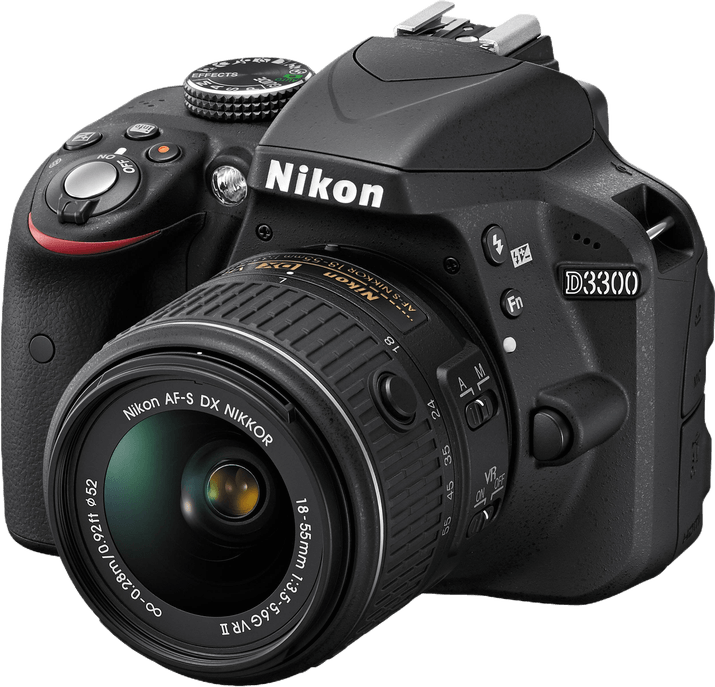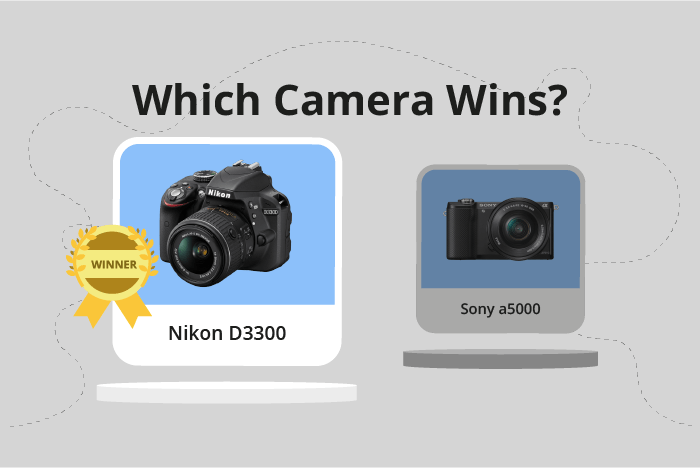Nikon D3300 vs Sony a5000 Comparison
Nikon D3300

Sony a5000

The Nikon D3300 edges out the Sony a5000 with a score of 55/100 to 51/100. Both cameras are from 2014 and have similar announcement dates. They also share common specifications like their DSLR and mirrorless camera types, respectively.
The Nikon D3300, being a DSLR, has a larger size of 124 x 98 x 76mm and weighs 430g / 0.95lbs. This might make it more comfortable to grip and hold for extended periods. Its higher score suggests it offers better performance and features.
On the other hand, the Sony a5000 is a mirrorless camera, making it more compact at 110 x 63 x 36mm and lighter at 269g / 0.59lbs. This could be an advantage for those who prioritize portability and convenience. Additionally, it has a lower launch price of $500 compared to the Nikon D3300’s $650.
Given these differences, the Nikon D3300 may be a better choice for those looking for enhanced performance, while the Sony a5000 may suit those seeking a more compact and affordable option.
Nikon D3300 vs Sony a5000 Overview and Optics
The Nikon D3300 outperforms the Sony a5000 in optics, scoring 64 out of 100 compared to the a5000’s 60. Both cameras share some common specifications, such as the CMOS sensor type, APS-C sensor size, and the lack of image stabilization. Despite these similarities, there are distinct differences between the two models that contribute to the Nikon D3300’s superior optics performance.
The Nikon D3300 boasts a higher megapixel count at 24.2, while the Sony a5000 has 20 megapixels. This difference allows the D3300 to capture more detailed images. Additionally, the D3300 has a faster shooting speed of 5 frames per second, compared to the a5000’s 3.5. This enables the D3300 to capture fast-moving subjects more effectively. The Nikon D3300 also has a higher DXOMARK sensor score of 82, compared to the Sony a5000’s 79, indicating better overall sensor performance.
The Sony a5000, however, has the advantage of a more versatile lens mount, the Sony E mount, which is compatible with a wider range of lenses. This can be beneficial for photographers who wish to explore different types of photography or require specific lenses for their work.
Taking into consideration the differences in megapixels, shooting speed, and sensor performance, it is evident that the Nikon D3300 is the stronger contender in terms of optics. Although the Sony a5000 has a more adaptable lens mount, the D3300’s superior performance in other areas ultimately makes it a better choice for those seeking higher-quality optics.
Nikon D3300 vs Sony a5000 Video Performance
The Sony a5000 emerges as the winner in the video capabilities comparison with a score of 70/100, while the Nikon D3300 falls behind with a score of 56/100. Both cameras share some common video specifications, including Full HD video resolution and maximum video dimensions of 1920 x 1080. Additionally, they both have a maximum video frame rate of 60fps.
The Sony a5000 outshines the Nikon D3300 in terms of video features, primarily due to its built-in time-lapse functionality. This feature allows for the creation of time-lapse videos without the need for additional software or equipment, making it a more versatile and user-friendly option for videographers.
The Nikon D3300, despite its lower video score, may still offer some advantages in certain situations. However, based on the provided specifications, it is difficult to pinpoint any specific areas where the Nikon D3300 surpasses the Sony a5000 in terms of video capabilities.
Taking these factors into account, the Sony a5000 is the superior choice for those prioritizing video capabilities in their camera selection. Its higher score reflects its advantage in features, specifically the time-lapse functionality, making it a more appealing option for videographers. Although the Nikon D3300 shares some common specifications with the Sony a5000, it lacks the additional features that set the Sony a5000 apart as the better camera for video recording.
Nikon D3300 vs Sony a5000 Features and Benefits
The Nikon D3300 outperforms the Sony a5000 in the features category, scoring 41/100 compared to the Sony a5000’s 37/100. Both cameras share some common specifications, such as a 3-inch screen size and the absence of a touchscreen, GPS, and Bluetooth capabilities. However, there are key differences that set them apart.
The Nikon D3300’s superiority in features is mainly due to its higher screen resolution of 921,000 dots, compared to the Sony a5000’s 460,800 dots. This higher resolution provides a clearer and sharper display, enhancing the user’s experience when reviewing photos or navigating the camera’s settings.
On the other hand, the Sony a5000 holds an advantage with its flip screen and built-in WiFi. The flip screen allows for more versatile shooting angles and is particularly useful for capturing self-portraits or video content. The built-in WiFi enables easy sharing of photos and remote control of the camera through a smartphone, adding convenience and flexibility to the user experience.
Despite the Nikon D3300’s higher feature score, the Sony a5000’s unique advantages may appeal to specific users depending on individual preferences and shooting requirements. However, based on the overall feature scores, the Nikon D3300 stands as the better camera in this comparison.
When choosing between these two cameras, potential buyers should consider their specific needs and preferences. The Nikon D3300 offers a higher screen resolution, while the Sony a5000 provides a flip screen and built-in WiFi for added versatility and convenience.
Nikon D3300 vs Sony a5000 Storage and Battery
The Nikon D3300 outperforms the Sony a5000 in storage and battery with a score of 32/100 compared to Sony’s 24/100. Both cameras possess a single memory card slot and accept SD, SDHC, and SDXC cards. However, the Sony a5000 also supports Memory Stick Pro Duo cards, providing an additional storage option.
The Nikon D3300 excels in battery life, offering 700 shots per charge, while the Sony a5000 only provides 420 shots. The D3300 uses an EN-EL14a battery, whereas the a5000 utilizes an NP-FW50 battery. Neither camera offers USB charging.
Though the Sony a5000 has an advantage in memory card compatibility, the Nikon D3300 clearly surpasses it in battery life, making it the better choice for extended shooting sessions. The longer battery life of the D3300 ensures photographers can capture more moments without worrying about battery replacement or recharging.
Alternatives to the Nikon D3300 and Sony a5000
Are you still undecided about which camera is right for you? Have a look at these popular comparisons that feature the Nikon D3300 or the Sony a5000:

